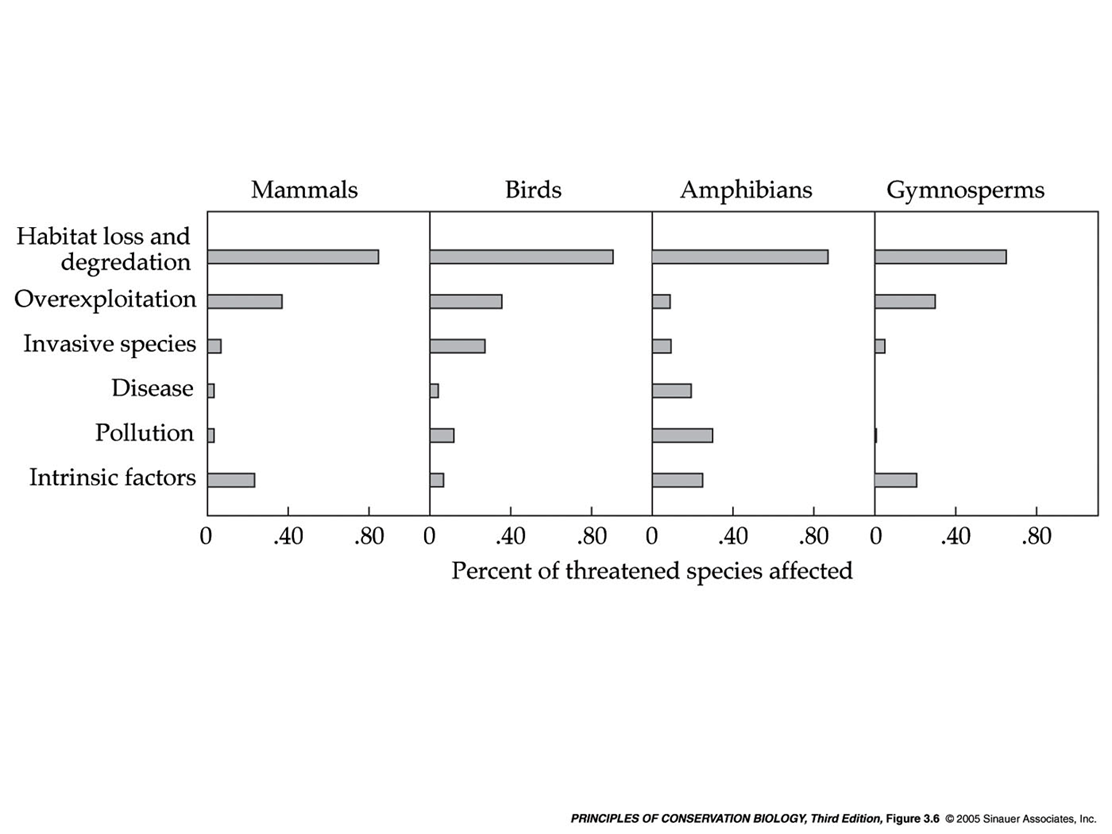Threats to Biodiversity
1/34
There's no tags or description
Looks like no tags are added yet.
Name | Mastery | Learn | Test | Matching | Spaced |
|---|
No study sessions yet.
35 Terms
Soule 2004 - traditional viewpoint of conservation
“Extinction is the most irreversible of all environmental calamities. With each plant & animal species that disappears, a precious part of creation is callously erased”
Modern view point of conservation
extinction, endangerment, and ecosystem are not the aims of human societies – they are an unfortunate byproduct of human activities (collateral damage)
What do we define as a threat?
There is no strict consensus, however, on what a threat is; sometimes hard to tell if an individual effect translates to a population level effect
Need to measure/quantify impacts
Threats to individuals may not threaten populations or species:
traditionally we call this a welfare issue not a conservation issue
the major threats to biodiversity HICOP
Habitat loss (land clearing, modification, fragmentation)
number one leading threat
Invasive species (disease, predation, competition)
Climate change (weather, sea level rise, acidification)
so far in terms of extinctions the least threatening but likely to rise
Overexploitation (overharvesting, overhunting, overfishing, poaching)
Pollution (burning of fossil fuels, dumping)

Habitat loss
no longer usable by biodiversity
Habitat degradation
more dangerous or difficult for organisms to live in. Caused by industry, agriculture, forestry, aquaculture, fishing, mining, sediment and groundwater extraction, infrastructure development, etc
Habitat fragmentation
reduces population viability
Invasive species
Introduction and successful colonization of species into places where they do not naturally occur
They can compromise native species through direct or indirect interactions
Invasive species - direct interactions
predation, competition, parasitism, disease, hybridization, toxins
Invasive species - indirect interactions
modifying habitats, disrupting species interactions, changing the relative densities of predators and prey
Climate change
caused major extinctions before (geological record)
global heating effects
extreme weather events
sea level rise
overexploitation
exploitation, hunting, fishing (legal)
Overexploitation, overharvesting, overfishing, overhunting, poaching (illegal)
Main uses: food, traditional medicine, pet trade, apparel
is now the #1 threat to many animal species
pollution
dumping of chemicals and plastics into the environment
burning of fossil fuels; circulation of chemicals atmospherically
can affect animal endocrine systems and other aspects of animal health
bioaccumulation
bioaccumulation
magnification of substances as you move up trophic levels
Multiple effects
many species, communities and ecosystems are under multiple threats (e.g., climate warming causing malaria to become an invasive species in northern Australia)
Synergistic effects
total impact of two or more threats = more than the sum of those independent impacts
Example: climate warming (coral bleaching) and fungal pathogens in corals
Global extinction
loss of a species from earth
Extirpation
loss of a species from one area/region
Functional extinction
reduced to such low densities that the species is likely to be unable to maintain populations (without intervention)
Ecological extinction
species reduced to such low densities that it is no longer relevant to other species or the community/ecosystem
Gopher tortoise – a keystone species
Gopher tortoises may be functionally & ecologically extinct in Louisiana
The Megafaunal extinctions
Humans contributed to historical extinctions, for example the megafauna extinctions
70-90% of genera of megafauna (>44 kg in size) went extinct during the last ice age (Pleistocene, 44,000-72,000 years ago in Australia, 10,000-15,000 years ago in North America)
These extinctions coincided with the arrival of humans in each area
Which was responsible, climate change or human hunting?
Pacific Island bird extinctions
1,000-3,000 years ago
Occurred as humans colonized the islands
>2,000 species (particularly flightless rails) driven extinct by overexploitation, habitat loss, the introduction of rats, pigs and other animals carried by the Polynesians
In some cases species went extinct within 100 years of human colonization
There were patterns in these extinctions
Loss of a of a critical species such as a top predator can lead to a
trophic cascade, whereby the prey of those predators increases, and their prey decrease, etc
Trophic cascade
whereby the prey of those predators increases, and their prey decrease, etc
Mesopredator (ecological) release
increase in subordinate predators in response to the loss of top predators
Keystone species
greater impact on other species in the community than would be expected based on its numbers or biomass (e.g., pollinators, large predators)
Dominant species
common and have a strong effect on other species in the community (e.g., corals, trees, large herbivores)
Ecosystem engineer
so strongly modify habitat that their loss affects other members of the community (e.g., beavers, elephants, gopher tortoises)
Which species/groups are most at risk?
China has the reputation of fueling extreme overharvest, due to the importance of traditional medicine, heavy involvement in the pet trade, and dependence on wild species for protein
Traditional medicine
The crocodile lizard is an endangered species
It is believed to have medicinal value for curing insomnia due to its ability to sit still for long periods of time
IUNC Red List
IUCN = International Union for Conservation of Nature
Systematic listing of threatened and endangered species to be used as a diagnostic tool to help establish extinction risk of all species
Categories: Extinct, Extinct in the wild, Critically Endangered, Endangered, Vulnerable, Near Threatened, Least Concern, Data Deficient, Not Evaluated
Criteria: declines, population size, extent of range
IUNC Red List Categories
Extinct, Extinct in the wild, Critically Endangered, Endangered, Vulnerable, Near Threatened, Least Concern, Data Deficient, Not Evaluated
IUNC Red List Criteria
declines, population size, extent of range